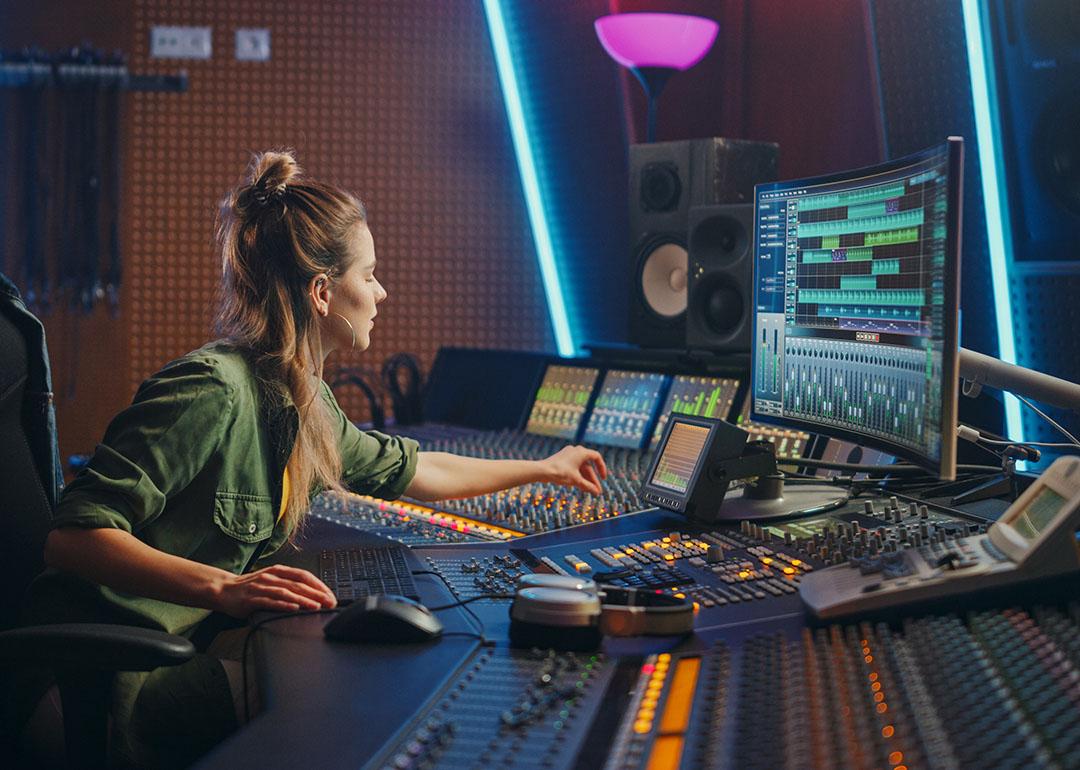
Exposing the music industry's gender bias
This story originally appeared on Skoove, was produced by DataPulse and was reviewed and distributed by Stacker Media.
Exposing the music industry's gender bias
Music is a form of creative expression that is celebrated across borders and cultures. But the business side of music isn't friendly to all creators. A wealth of evidence suggests that the music industry elevates men above other genders to an alarming degree.
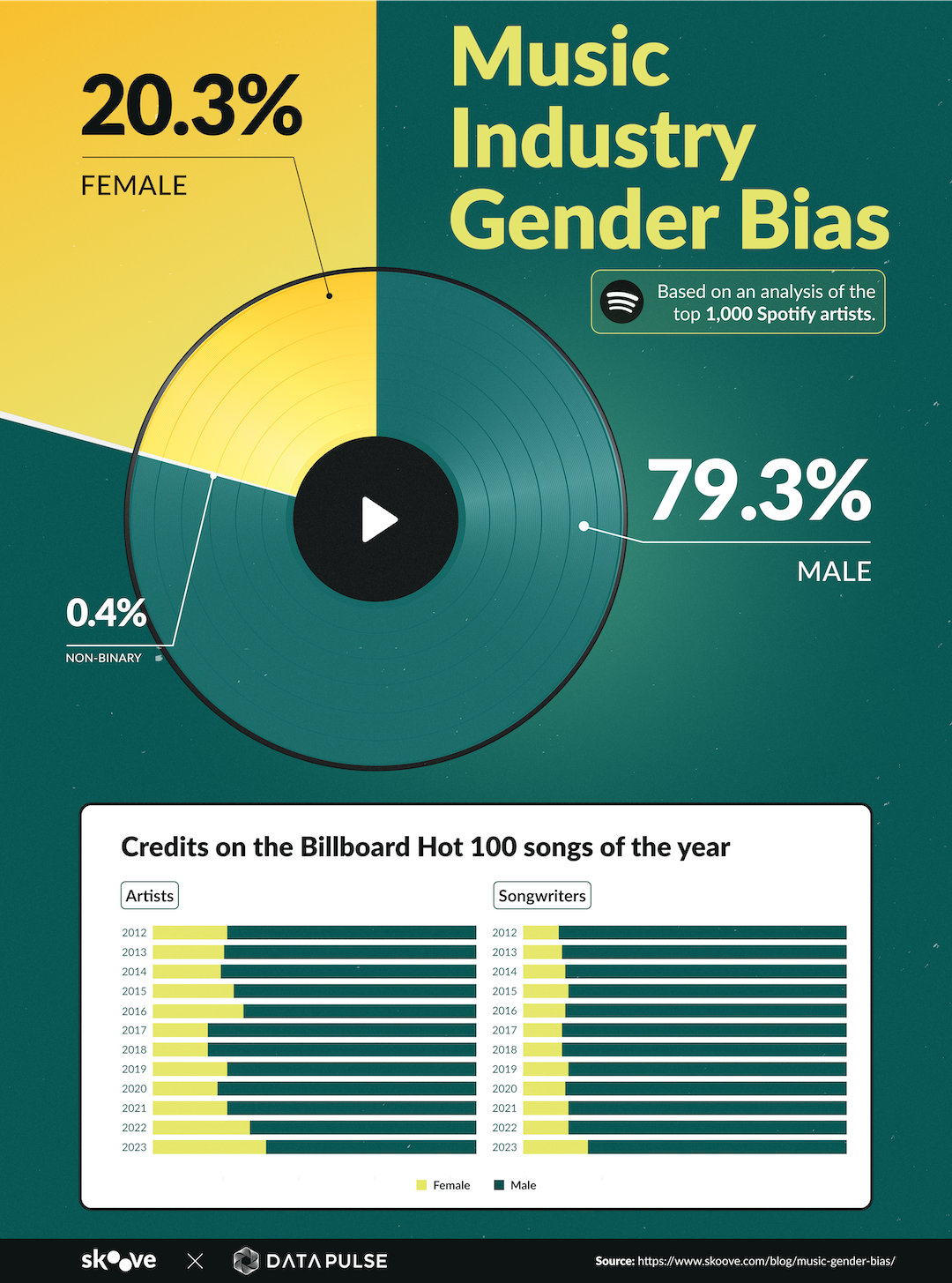
No doubt, males rule
Skoove first explored this gender disparity in an article about top Spotify musicians. That story, based on an analysis of 1,000 artists conducted by data research firm DataPulse, found that global superstars like Taylor Swift, Ariana Grande, Billie Eilish, Dua Lipa, and Rihanna, are outliers in an industry dominated by male artists. Overall, about 80% of the top 1,000 Spotify artists are men (including one trans male) compared with only 20% who are women (including one trans female) and less than 1% who are nonbinary.

An unwelcoming industry
Skoove and Data Pulse teamed up again to better understand the extent of women's exclusion and why it's happening. After combing through studies, reports, surveys, and government statistics on the subject, we found that gender disparities exist throughout the music industry, from songwriting and production to performances and accolades. Because some sources used male/female designations while others used men/women, we used both designations. Here are some of the top insights.
Misogyny, homophobia, and sexism are rampant in the music industry. Don't take it from us. Take it from artists — both newbies and the superstars — who experience it.
"The music industry can be, as you know, a bit homophobic, a bit sexist at times," said Sam Smith, a nonbinary singer and songwriter, when speaking on SiriusXM in 2019. "So being feminine like this in the way that I move and dance and am is—it feels quite scary at times."
"I've politely walked out of sessions before," said Ariana Grande in an interview with Billboard. "And then I sit down and comp my own vocals and can produce my own session, and they're like 'Oh, I didn't know you could do that.' I'm like, 'Believe it or not, there are plenty of tiny women that can do this.'"
In 2019, the Berklee College of Music published a comprehensive survey of U.S. music professionals from both the creative side of the industry (performers, songwriters, and producers), and business side (managers, administrators, and artist developers). Among the nearly 2,000 women respondents, more than three-quarters had experienced gender bias in the music industry, and just over half felt their gender had affected their job prospects.
The creative professionals were more likely than the business professionals to say gender impacted their jobs. In particular, 70% of producers and recorders, 68% of performers, and 57% of music creators and songwriters experienced gender bias that affected their employment.
This bias translates to major gender disparities across the industry. According to the U.S. Bureau of Labor Statistics, only about 1 in 4 musicians and singers in the country are women. This alarming level of underrepresentation reaffirms the findings from our prior Spotify analysis and clearly attests to the barriers women face in gaining visibility and opportunities in the field.
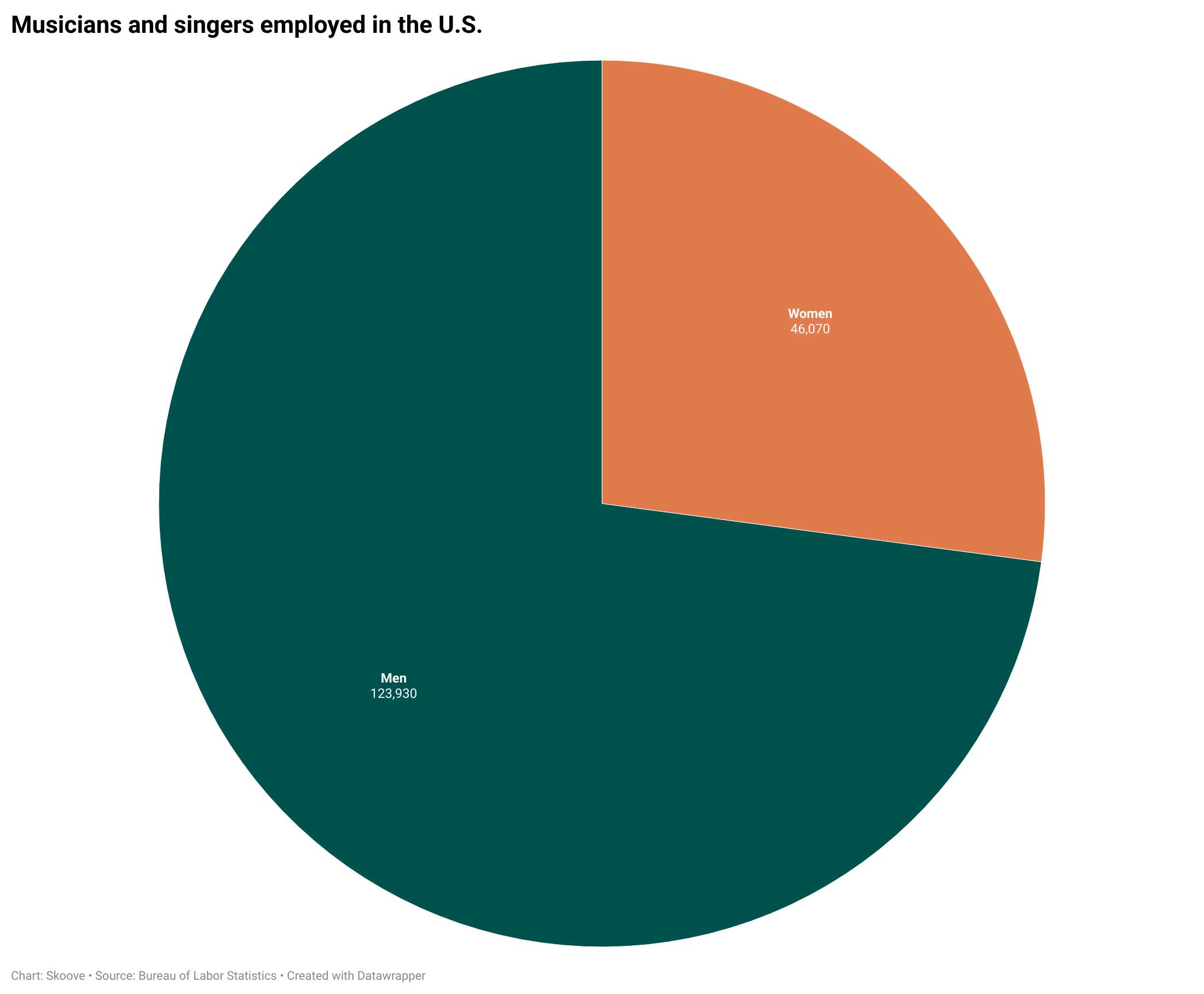
Female artists struggle to make gains
The Berklee survey, which broke out results by age, found that 75% to 82% of women in the music field from ages 18-59 had experienced different treatment due to their gender (Women in the industry over age 60 fared a little better, with 69% reporting bias.)
Women's struggle to get to the top is clearly evident in listener charts such as the year-end Billboard Hot 100, which ranks the best-performing singles of the U.S. Over the last 12 years, there have been 3.3 men to every 1 woman artist on the charts, according to a January 2024 report from the Annenberg Inclusion Initiative at the University of Southern California. Among songwriters, the ratio is even worse, at 6.5 men to 1 woman. There are several reasons for the gender gap. The industry, notes the report, persistently stereotypes women's creative output and the roles they can hold. It also routinely sexualizes them and doubts their talent and experience.
There has been a notable increase in the number of women artists on the charts in recent years, and their share has grown relatively steadily since about 2017. But the disparity is still alarming, with women accounting for about a third of the artists in 2023 — an all-time high.
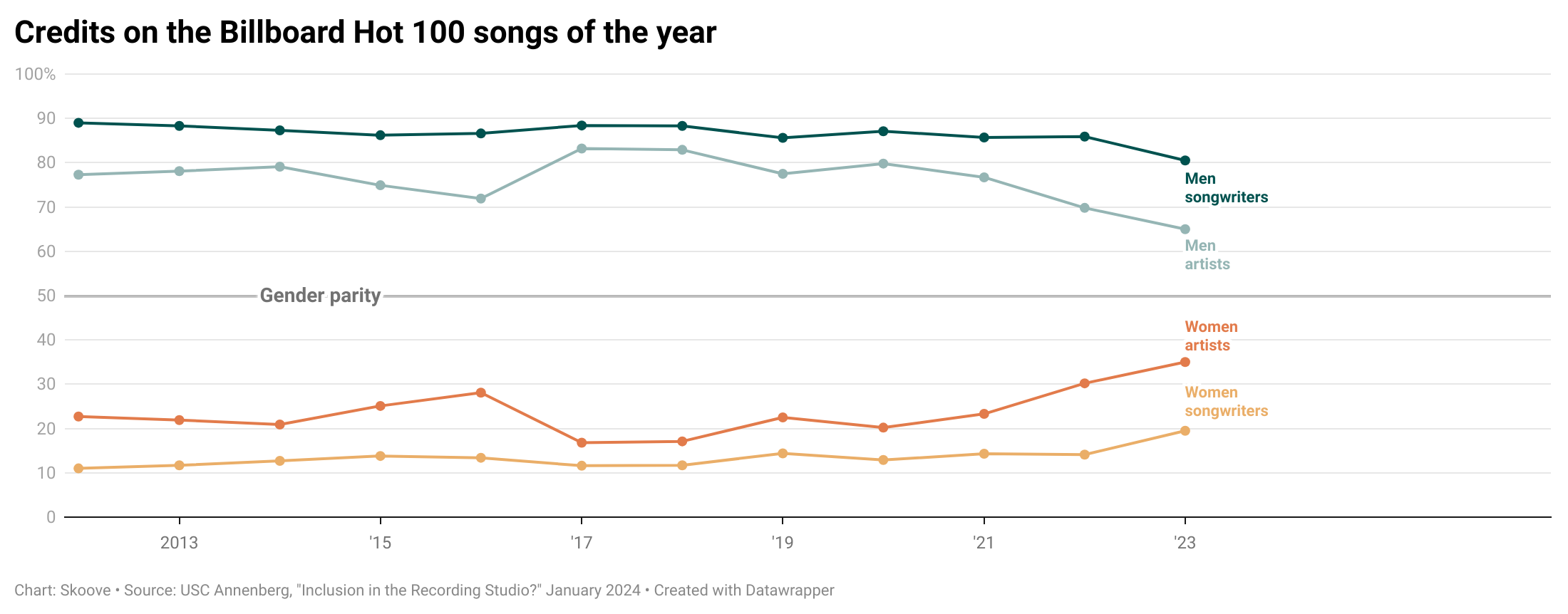
Vocabulary differs for male and female artists
Numerous artists have publicly attested to the industry's structure and culture that deters women's participation. For example, Taylor Swift described the scrutiny she faces compared with her male counterparts in a 2019 interview with CBS Sunday Morning. "You're always going to have people going, 'Did she write all her own songs?'" she said. "There's a different vocabulary for men and women in the music industry. A man does something, it's strategic. A woman does the same thing, it's calculated. A man is allowed to react. A woman can only overreact."
Swift is one of the most credited artists on the Billboard Hot 100 list over the last 12 years, as the chart below shows. Still, she and the other top individual women artists are outnumbered by men.
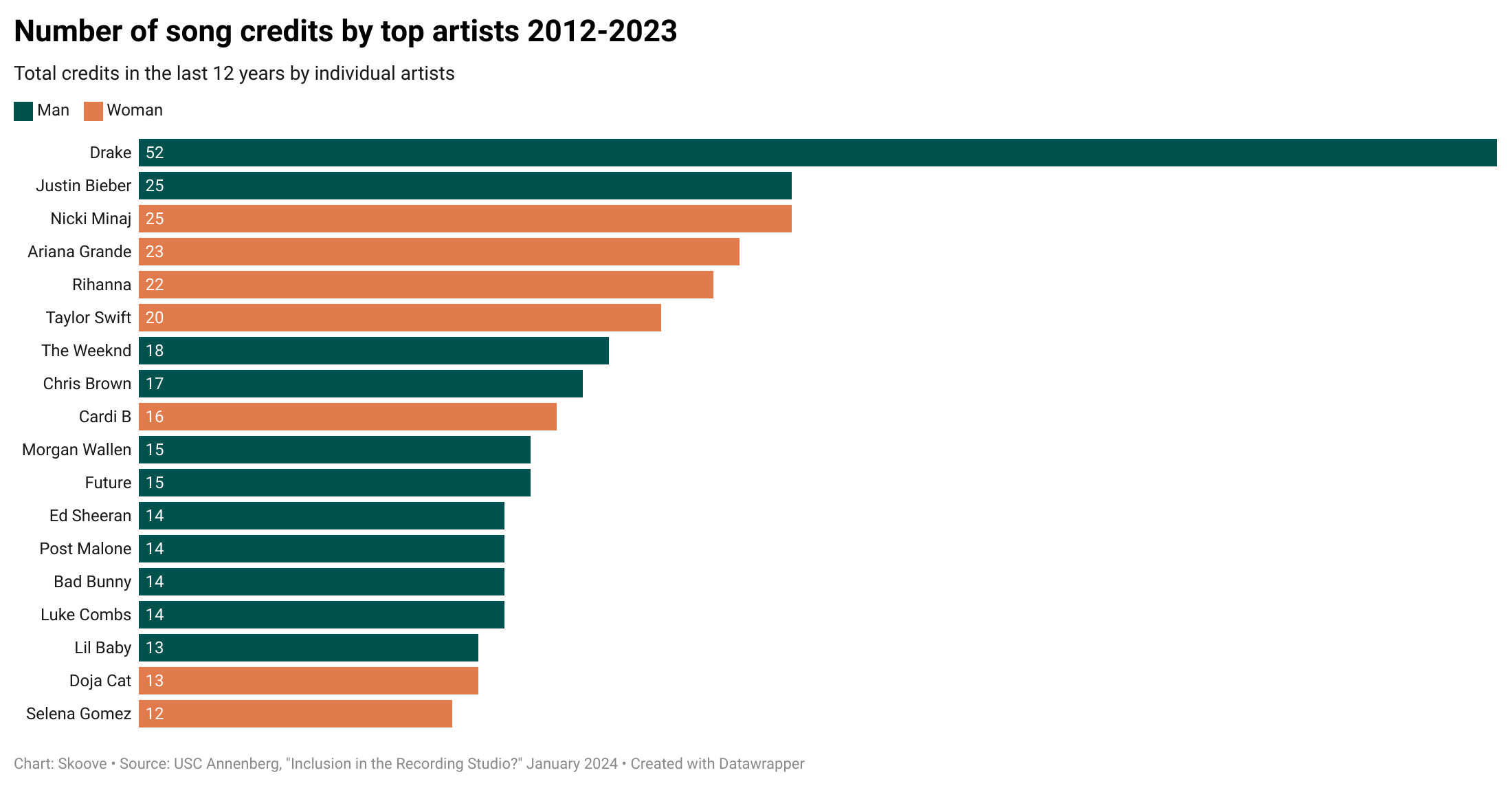
Women want their props
As songwriters, Nicki Minaj and Taylor Swift are the only women who have earned at least 20 credits on the year-end Billboard Hot 100 charts since 2012. Nine male songwriters have accomplished the same, including three men who have more than 30.
Minaj hasn't been shy about her experience with sexism and her frustrations with trying to get recognition and credit as a woman artist. "I'd have to wear some baggy pants n timbs for men to openly give props," she griped on Twitter in 2017, along with a series of tweets about double standards.
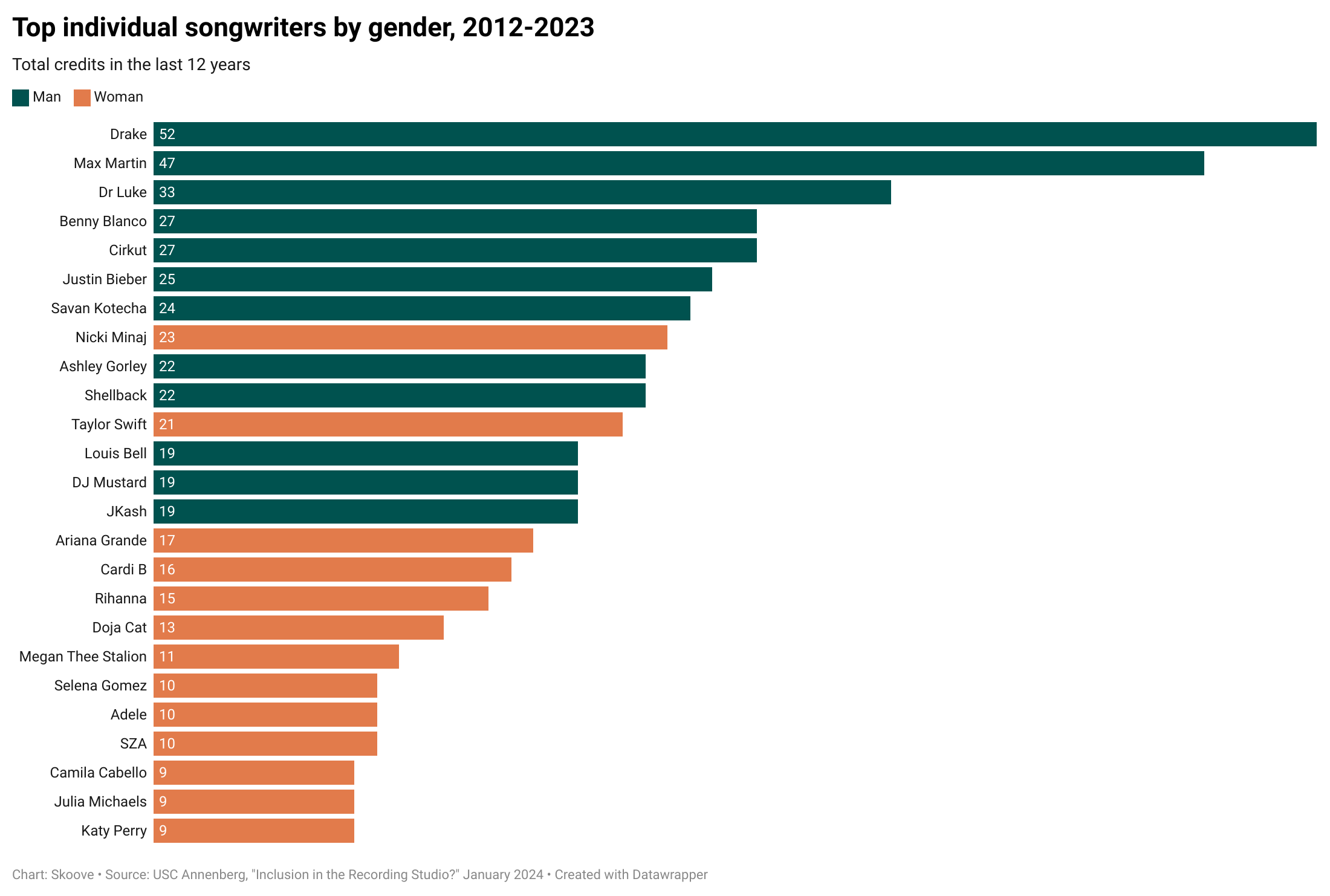
Problems in the studios
Music creation relies heavily on technical talent, such as producers and engineers. They make sure the singers and musicians are showcased at their best during recording and mixing. Women, unfortunately, are rarely part of that key process.
In 2023, "Fix The Mix" became the first major study of gender representation across audio production and engineering personnel. The report, a collaboration between the nonprofit We Are Moving The Needle and music credits database Jaxsta, analyzed 3,785 technical credits on the top-50 songs of 14 genres according to streaming data from Apple Music and Spotify. In total, the analysis encompassed 634 individual songs (some straddled multiple genres).
The study concluded that, out of 1,260 total music producers, only 65 were women and nonbinary people (5%). The numbers were similarly dismal for engineers — only 46 out of 1,480 (3%).
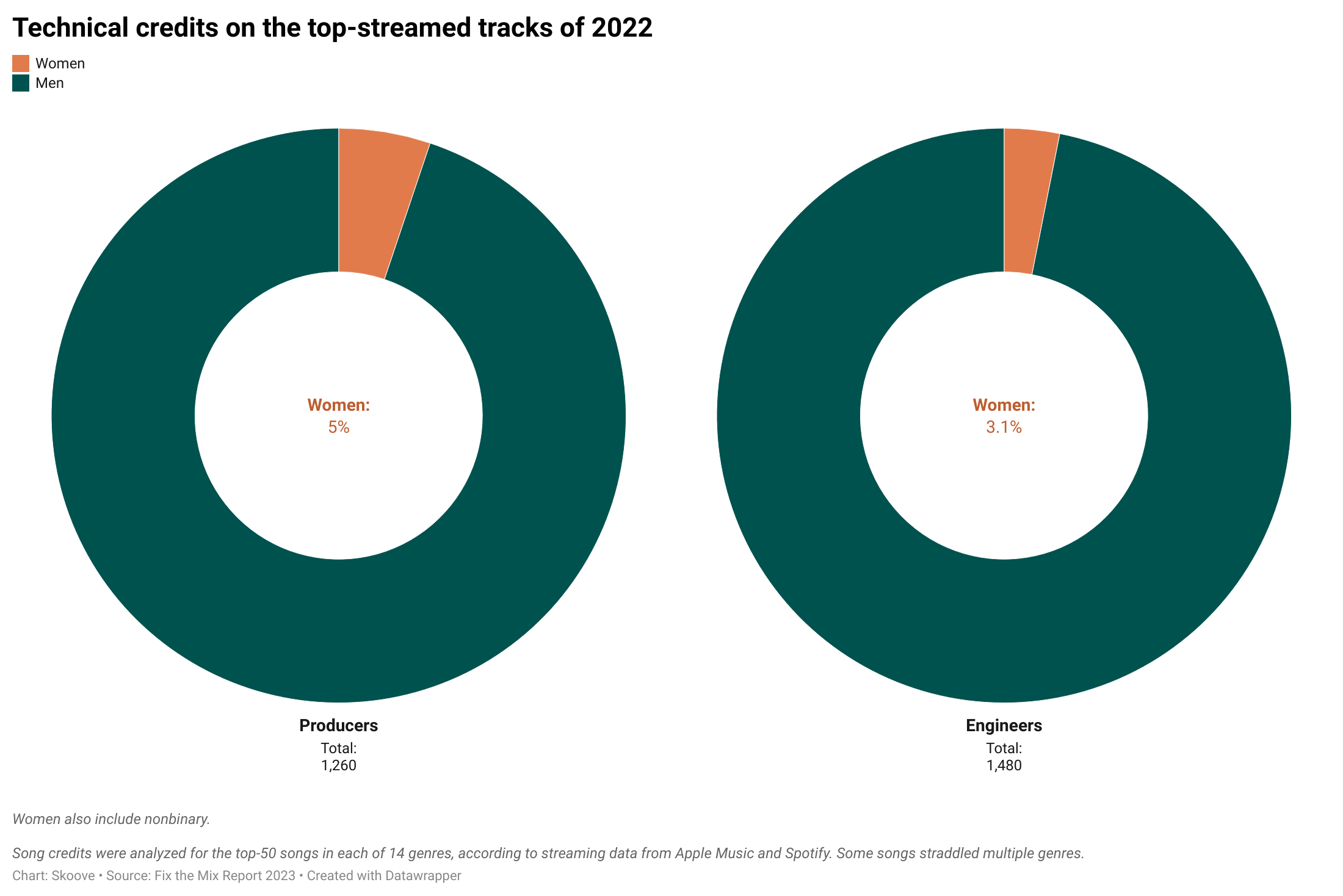
Pop tops female representation over rap and hip-hop
In Skoove's prior gender analysis of top musical artists, we found that female representation varied by genre. Latin, hip hop, and rap have extremely low rates of women artists, for example, while pop music has the most female representation, at 38%.
Similarly, the Fix The Mix report found that gender imbalances among music technicians differed by genre. As the following chart shows, women received the most credits in the electronic and folk/Americana genres, but still only accounted for 11% of those credits. Of the 14 genres in the analysis, metal had the worst inclusion record — it was completely dominated by male producers and engineers.
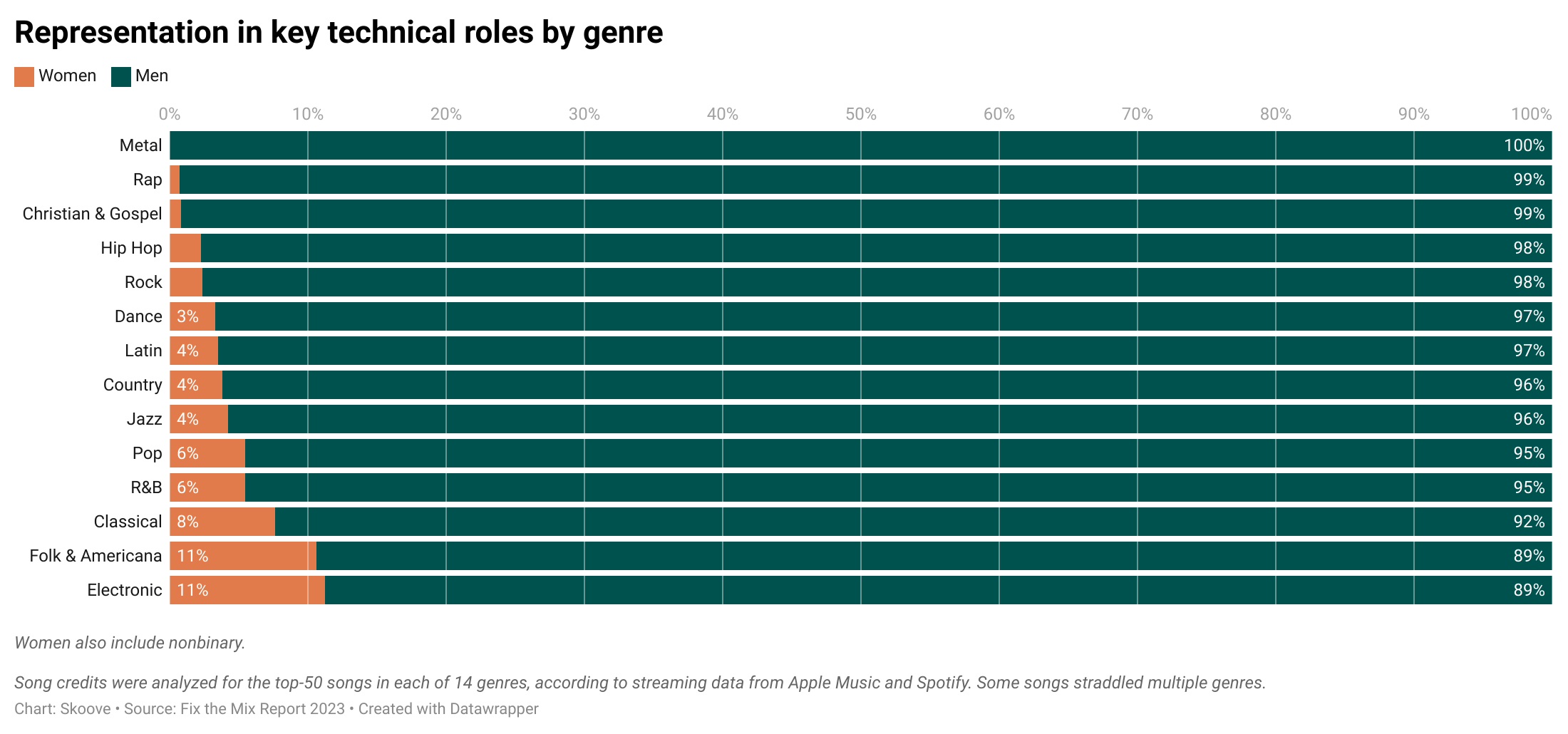
Barely any credit for women technicians among distributors
The study went further, breaking out gender gaps by label. The analysis looked at the top-10 songs across five streaming services and across 14 genres. The results were sobering. Songs distributed by Universal Music Group, which accounts for 40% of the music in the dataset, had only a small fraction (4%) of women and nonbinary technicians credited. Sony and Warner, each with about 20% of the songs in the database, had 6% and 3%, respectively.
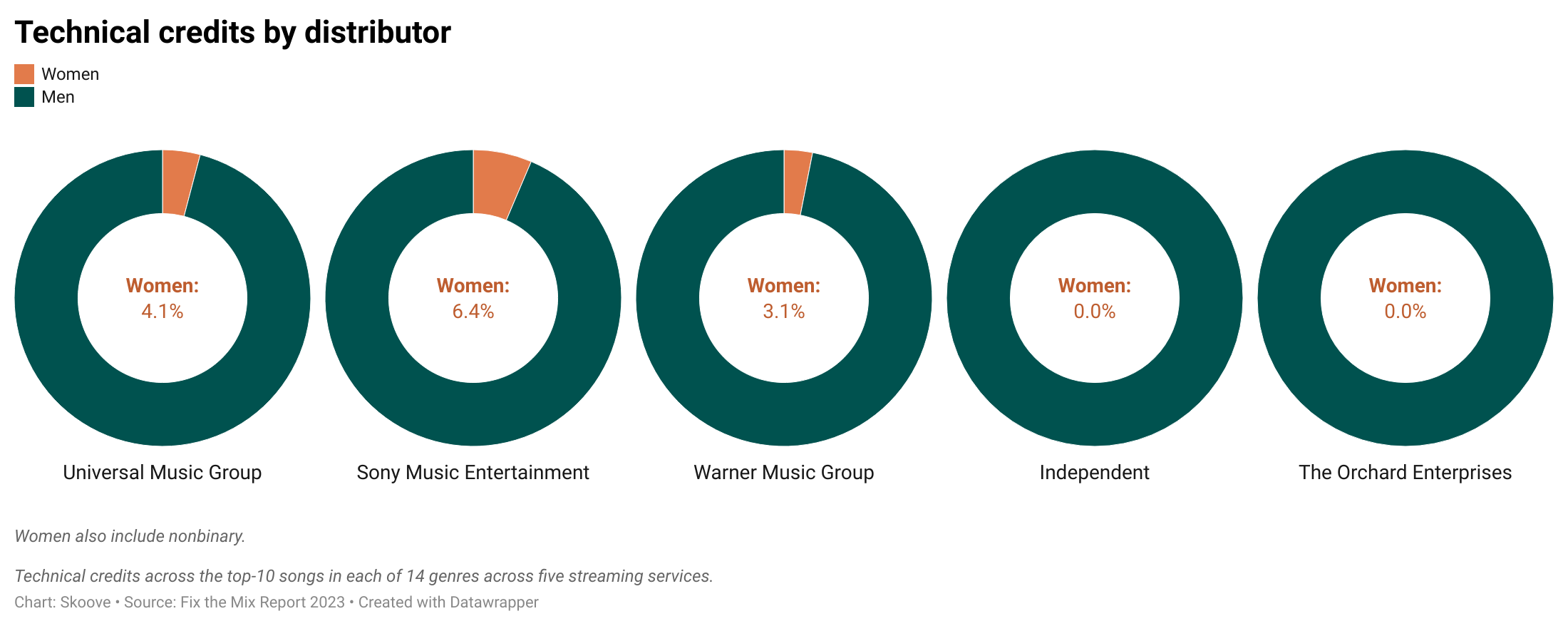
Hesitant to change
The report's authors noted that big music companies can make policy changes that could ripple through the industry. "Hiring practices have continued to reinforce skewed gender visibility trends," they explained. "Structures of power are hesitant to shift support from those that have historically benefitted the most from them."
Less opportunity, less exposure, less recognition
Women across the industry have repeatedly expressed frustration with the expectations their peers in the industry, their audiences, and the media set for them. "Women in music are allowed to be singer songwriters singing about their boyfriends," wrote Björk on Facebook several years ago. "If they change the subject matter to atoms, galaxies, activism, nerdy math beat editing or anything else other than being performers singing about their loved ones they get criticized."
Other women have talked openly about being sexualized and objectified. In an interview with Variety, in late 2023, Billie Eilish said people scrutinize what she looks like and how she dresses. "Nobody ever says a thing about men's bodies," she said. "If you're muscular, cool. If you're not, cool. If you're rail thin, cool. If you have a dad bod, cool. If you're pudgy, love it!"
Lady Gaga shared a similar sentiment when she spoke with Glamour in 2017: "As much as we all love the fashion and the makeup and the glamour, this isn't a beauty pageant. It's about the heart and the drive and the work."
From their wardrobes to their lyrics, women feel pressure to fit a certain mold to get noticed. It's a systemic problem driven by exploitation and rejection that permeates the industry — and it's keeping women from getting the opportunities they deserve.
For instance, in 2023, only 30% of acts at electronic music festivals worldwide were female, and 3.3% were nonbinary, according to a report from female:pressure, a network and data hub for underrepresented members of the electronic music scene. While this is an improvement over the last decade (only 9.2% of acts were female in 2012), there's a long road ahead. Perhaps the all-female band Camp Cope put it best in their song "The Opener":
It's another man telling us we can't fill up the room
It's another man telling us to book a smaller venue
Nah, hey, come on girls, we're only thinking about you
Now look how far we've come not listening to you
Yeah, just get a female opener, that'll fill the quota

Classic scene not immune from gender disparities
The classical music scene isn't immune from gender disparities, either. Research by Arts Council England found that "though women make up a substantial portion of the workforce, they are less represented in senior roles like orchestral principals, as solo artists, in artistic leadership roles and elsewhere." What's more, in 2018, Quartz examined the world's 20 greatest orchestras and determined that 69% of the full-time instrument players were men.
In early 2024, the U.K. Parliament's House of Commons issued a scathing report on misogyny in the music industry, calling out the numerous barriers that keep women from pursuing a music career. The list includes gatekeeping and lack of support, discrimination and bullying, objectification and sexualization, and abuse and sexual harassment.
It's hardly a wonder, given the myriad challenges, that women struggle to feel seen in the industry, let alone achieve high accolades like Grammy nominations and awards. In the chart below, which shows five major Grammy Award categories, only "Best New Artist" has given women and men nominations in relatively equal measure. However, over the last 12 years, far fewer women have been contenders for Record of the Year, Album of the Year, Song of the Year, and Producer of the Year.
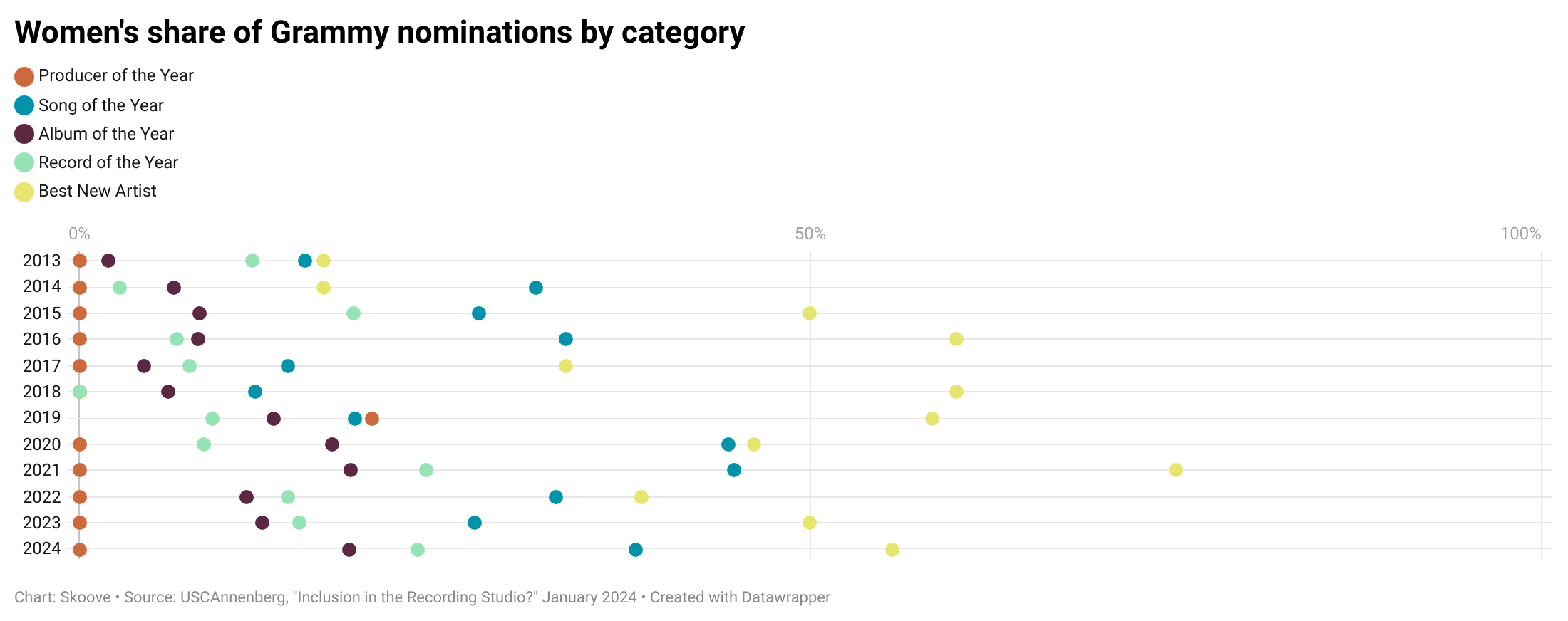
Toward a harmonious future
The music industry, despite its progressive veneer, continues to lag in gender equality, heavily favoring men in both visibility and opportunity. This imbalance is a systemic issue, rooted in years of cultural and structural biases.
Still, there are signs that things are changing.
In recent years, there's been a slight, yet promising, increase in the visibility of female artists and professionals. Initiatives and organizations like Keychange and Women in Music (among many others) are pushing the industry to do better by holding stakeholders accountable for the disparity and advocating for gender balance at festivals and in boardrooms. The growing awareness of the problem is starting to pay off; more women were on the Billboard Hot 100 charts than ever before in 2023.
"We're doing great, we're making great strides and I'm proud to be a woman in this business," said Dolly Parton as she arrived at the Grammy Awards ceremony in 2019.
But more has to be done to not lose this momentum and ensure that women feel welcomed and supported across the industry. Many of the reports cited in this article contain recommendations for change. But one of the most frequent suggestions is to put women and nonbinary people in leadership and decision-making roles within the industry. As the U.K. Parliament report put it, "The lack of women in positions of authority sets the culture and influences decisions for the rest of the profession and can have a direct impact on women's career opportunities and progression."
In an industry that thrives on creativity, the inclusion of diverse voices is not just fair. It's also beneficial, enriching the music industry with untapped perspectives and talents.



